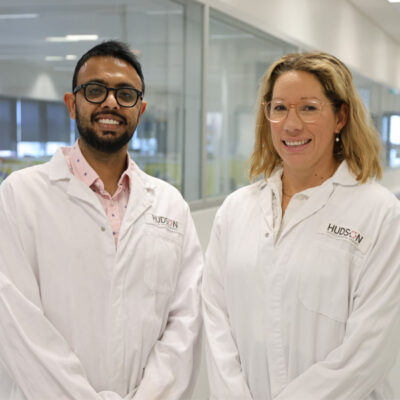Spirit of place – Hudson reconciliation reflected in Indigenous artwork
By Rob Clancy, staff writer
An Indigenous artwork in the foyer of Hudson Institute marks a new chapter in our history, as we look to our past and to the future with equal pride.

The unveiling of the Indigenous artwork coincides with the Institute registering with Reconciliation Australia and beginning development of a Reconciliation Action Plan (RAP).
Titled Ya-yanha Daborra, meaning ‘to go along a pathway’ in Yorta Yorta language, the spectacular Indigenous artwork was commissioned by Hudson Institute and created by brother and sister team Luke and Siena Tieri from Bayadherra.
Its design represents engagement and connection between the Institute, Aboriginal and Torres Strait Islander communities and our industry colleagues.
Indigenous artwork reflects community engagement
Luke Tieri said the finished artwork took 40 hours to complete and they chose colours that reflect Hudson Institute and its engagement with community.
“Incorporating Hudson’s colours personalises the Indigenous artwork and makes it representative of the ways Hudson Institute is engaging with colleagues and community, and building relationships with Aboriginal and Torres Strait Islander peoples,” he said.
Siena Tieri said the process of developing the Indigenous artwork was fluid and organic: “We started with a light sketch of the design on the canvas and developed and evolved elements as we progressed,” she said.
“We completed the central component first – the yarning circles and learning pathways – before moving outwards.
“The dashed orange line depicting Hudson Institute’s reconciliation journey was originally blue – we changed it to orange to be brighter and more prominent in the painting.”
It was a fitting choice, according to Dr Jason Cain, who chairs Hudson Institute’s Institute’s Equity and Diversity Committee.
“We are in the early stages of developing a Reconciliation Action Plan that will outlay all of Hudson Institute’s Aboriginal and Torres Strait Islander priorities and actions,” Dr Cain said.
Committed to promoting reconciliation
“Hudson Institute is committed to promoting reconciliation and improving awareness, education and inclusion of Aboriginal and Torres Strait Islander people, as part of our broader diversity and inclusion agenda.”
The process of developing the ‘Reflect’ RAP will occur over the coming months and involves scoping and developing relationships with Aboriginal and Torres Strait Islander stakeholders, deciding on our vision for reconciliation and exploring our sphere of influence.
The elements of the Indigenous artwork are described below, by the artists Luke and Siena Tieri.
Three large pink and orange yarning circles depict the development of respectful and meaningful relationships between the three communities and are linked by purple learning pathways.
These pathways are strengthened through the sharing of cultural knowledge, understanding and demonstrate Hudson’s commitment to advance reconciliation through cross-culture collaboration.
The four smaller yarning circles linking to the larger yarning circle have multiple interpretations:
• The four stages of Hudson’s reconciliation journey: Reflect, Innovate, Stretch and Elevate.
• Hudson’s core business values: excellence, innovation, partnership and community.
• Hudson’s ongoing company growth in their five main research areas, emphasised by the expansion of purple and orange dots.
Pink and orange lines depicts a patient’s healthcare journey towards healing. Along this journey line are purple U shapes that depict people. This represents support from Hudson, industry colleagues and community to deliver positive health outcomes for Aboriginal and Torres Strait Islander communities, transforming lives.
The orange circles surrounded by light purple dots reflect the communities and colleagues Hudson is yet to engage with. The dashed orange line symbolises Hudson’s reconciliation journey. Both these elements promote the idea of fostering future connections with community symbolising Hudson’s commitment to reconciliation.
The surrounding elements of the artwork represent Country.
Blue dots depict water, green dots depict the land, pink dots depict bush tucker and the blended circles represent native plants.
These elements acknowledge the lands of Traditional Custodians and bush medicines that were traditionally derived from Country.
Our spiritual connection to Country and the ways Country provides for community is an important part of culture and healing.
Contact us
Hudson Institute communications
t: + 61 3 8572 2761
e: communications@hudson.org.au
In this article
About Hudson Institute
Hudson Institute’ s research programs deliver in three areas of medical need – inflammation, cancer, women’s and newborn health. More
Hudson News
Get the inside view on discoveries and patient stories
“Thank you Hudson Institute researchers. Your work brings such hope to all women with ovarian cancer knowing that potentially women in the future won't have to go through what we have!”



